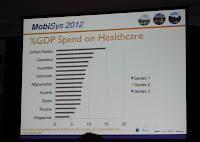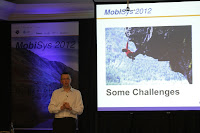 Florian Alt defended his PhD thesis “A Design Space for Pervasive Advertising on Public Displays” at the University of Stuttgart. Over the last years Florian work at the crossroads of interactive public displays and pervasive advertising. His research output during the last years and while working on the http://pd-net.org project was amazing, see his DBLP entry.
Florian Alt defended his PhD thesis “A Design Space for Pervasive Advertising on Public Displays” at the University of Stuttgart. Over the last years Florian work at the crossroads of interactive public displays and pervasive advertising. His research output during the last years and while working on the http://pd-net.org project was amazing, see his DBLP entry.
 The dissertation will be soon available online. If you are curious about his work right now, there are a few papers or a book you should read. A high level description of the findings is described in a paper published in IEEE Computer on Advertising on Public Display Networks [1]. The initial paper that paved the way towards understanding design space of public displays [2] is providing a comprehensive descriptions of ways for interaction with public displays. One of the highlights of the experimental research is the paper “Looking glass: a field study on noticing interactivity of a shop window” [3], which was done during Florian’s time at Telekom Innovation Laboratories in Berlin (it received a best paper award at CHI 2012). Towards the end of the thesis everyone realizes that evaluation is a most tricky thing, hence there is one paper on “How to evaluate public displays” [4]. If you are more interested on the advertising side, have a look at the book he co-edited with Jörg Müller and Daniel Michelis: Pervasive Advertising by Springer Verlag, 2011, available as kindle version at Amazon.
The dissertation will be soon available online. If you are curious about his work right now, there are a few papers or a book you should read. A high level description of the findings is described in a paper published in IEEE Computer on Advertising on Public Display Networks [1]. The initial paper that paved the way towards understanding design space of public displays [2] is providing a comprehensive descriptions of ways for interaction with public displays. One of the highlights of the experimental research is the paper “Looking glass: a field study on noticing interactivity of a shop window” [3], which was done during Florian’s time at Telekom Innovation Laboratories in Berlin (it received a best paper award at CHI 2012). Towards the end of the thesis everyone realizes that evaluation is a most tricky thing, hence there is one paper on “How to evaluate public displays” [4]. If you are more interested on the advertising side, have a look at the book he co-edited with Jörg Müller and Daniel Michelis: Pervasive Advertising by Springer Verlag, 2011, available as kindle version at Amazon.
Florian joined my research group already back in Munich as a student researcher, where we explored ubiquitous computing technologies in a hospital environment [5]. He followed to Fraunhofer IAIS to do his MSc thesis, where he created a web annotation system that allowed parasitic applications on the WWW [6]. I nearly believed him lost, when he moved to New York – but he came back to start his PhD in Duisburg-Essen… and after one more move in 2011 to the University of Stuttgart he graduated last week! Congratulations! He is no. 6 following Dagmar Kern, Heiko Drewes, Paul Holleis, Matthias Kranz, and Enrico Rukzio. The photo shows the current team in Stuttgart – when looking at the picture it seems there are soon more to come 😉
References
[1] Alt, F.; Schmidt, A.; Müller, J.; , „Advertising on Public Display Networks,“ Computer , vol.45, no.5, pp.50-56, May 2012. DOI: 10.1109/MC.2012.150, URL: http://ieeexplore.ieee.org/stamp/stamp.jsp?tp=&arnumber=6193076&isnumber=6197765
[2] Jörg Müller, Florian Alt, Daniel Michelis, and Albrecht Schmidt. 2010. Requirements and design space for interactive public displays. In Proceedings of the international conference on Multimedia (MM ’10). ACM, New York, NY, USA, 1285-1294. DOI=10.1145/1873951.1874203 http://doi.acm.org/10.1145/1873951.1874203
[3] Jörg Müller, Robert Walter, Gilles Bailly, Michael Nischt, and Florian Alt. 2012. Looking glass: a field study on noticing interactivity of a shop window. In Proceedings of the SIGCHI Conference on Human Factors in Computing Systems (CHI ’12). ACM, New York, NY, USA, 297-306. DOI=10.1145/2207676.2207718 http://doi.acm.org/10.1145/2207676.2207718
[4] Florian Alt, Stefan Schneegaß, Albrecht Schmidt, Jörg Müller, and Nemanja Memarovic. 2012. How to evaluate public displays. In Proceedings of the 2012 International Symposium on Pervasive Displays (PerDis ’12). ACM, New York, NY, USA, , Article 17 , 6 pages. DOI=10.1145/2307798.2307815 http://doi.acm.org/10.1145/2307798.2307815
[5] A. Schmidt, F. Alt, D. Wilhelm, J. Niggemann, and H. Feussner, Experimenting with ubiquitous computing technologies in productive environments. Journal Elektrotechnik und Informationstechnik. 2006, 135-139.
[6] Florian Alt, Albrecht Schmidt, Richard Atterer, and Paul Holleis. 2009. Bringing Web 2.0 to the Old Web: A Platform for Parasitic Applications. In Proceedings of the 12th IFIP TC 13 International Conference on Human-Computer Interaction: Part I (INTERACT ’09). Springer-Verlag, Berlin, Heidelberg, 405-418. DOI=10.1007/978-3-642-03655-2_44 http://dx.doi.org/10.1007/978-3-642-03655-2_44








